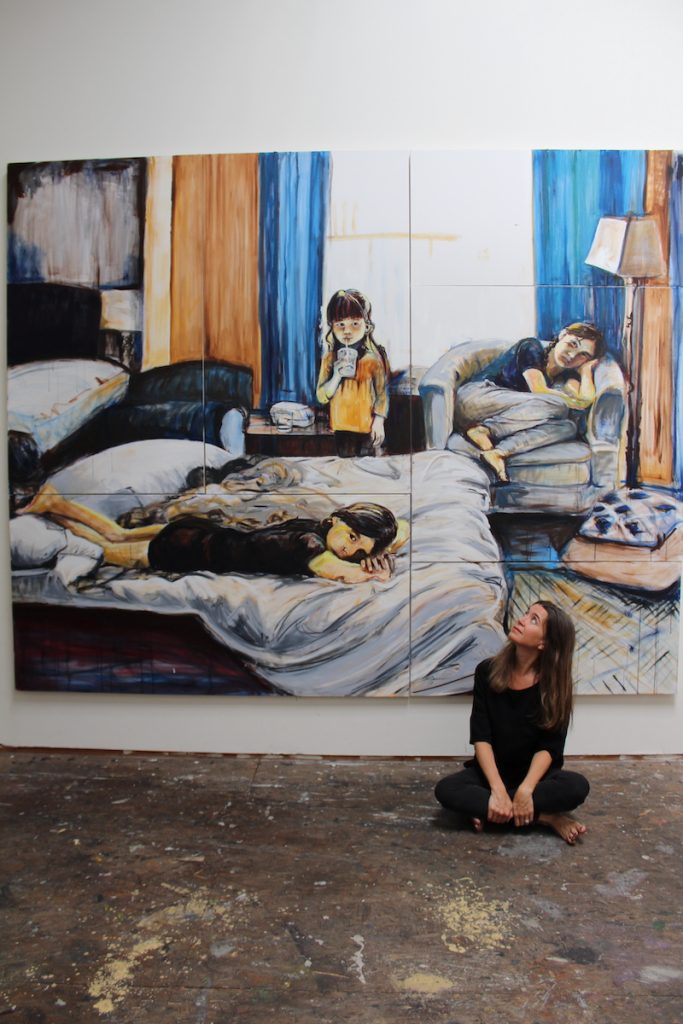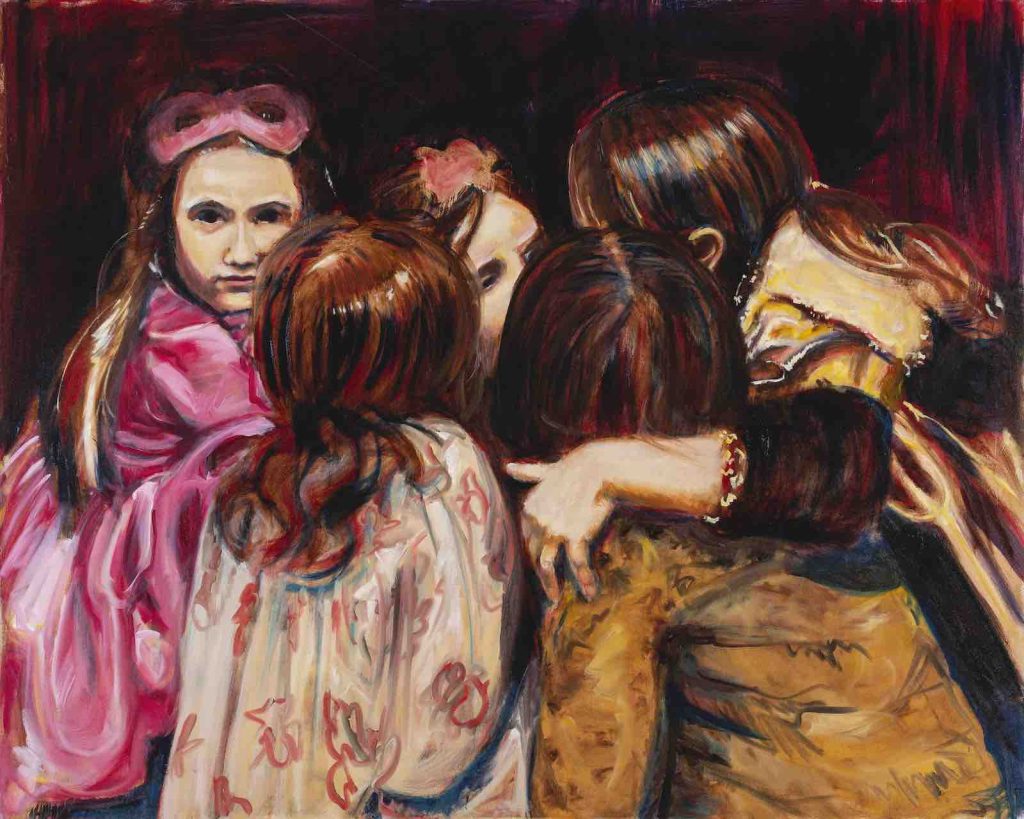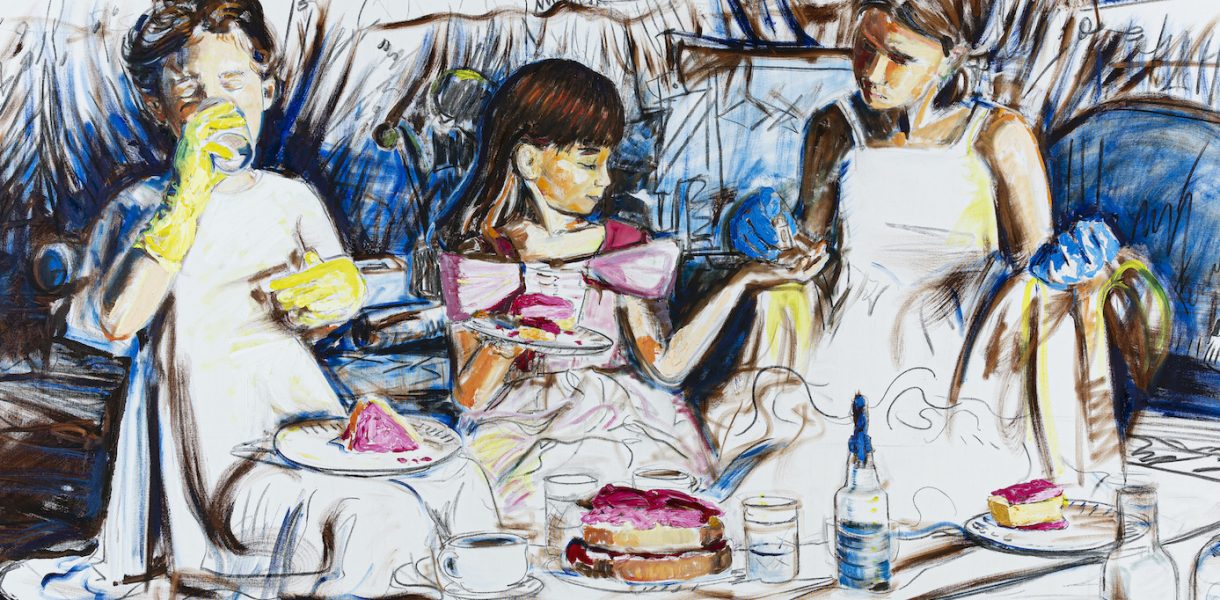By Mario Hernandez
Portraits are among the earliest forms of painting, often cited as dating back to the Ancient Egyptians, Greeks and Romans. As Alison Smith, chief curator at the National Portrait Gallery in London notes, “portraiture stands apart from other genres of art as it marks the intersection between portrait, biography and history.” Moreover, as the Tate notes on its website, “portraits have always been more than just a record. They have been used to show the power, importance, virtue, beauty, wealth, taste, learning or other qualities of the sitter.”

Many of these themes pervade the work of the artist Christine Ferrouge, but she also questions such concepts in important ways through her subject matter. In often subtle terms, her work engages questions on the historical significance of art and its ongoing and potential to impact our lives. She does this through an interrogation of the intimate sphere of family life, childhood and girlhood identity.
An artist, educator and curator, Ferrouge has been making art in Oakland for over 16 years. She has studied in cities around the world including Florence, Amsterdam, the Dominican Republic and Madrid. She spent 5 weeks in the latter, where she spent much of her time visiting the Prado, studying the works of the early masters including Goya and Velasquez. The figures in her own work simultaneously bear the influence of this long artistic trajectory while also depicting the mundane moments of contemporary life. Such moments often reveal a rich inner world of intimacy and meaning.
As stated on her website, the artist “paints girlhood in the natural and social environments of contemporary childhood”. In doing so, she reveals strong and dignified future women, “who grapple with their world through the serious business of childhood”. Very few male subjects appear in her work. Instead, her focus is primarily on the world of adolescent girls, where her subjects seem to create and recreate worlds unto themselves. It is one in which they are safe, comfortable and confident. And it is a world that fosters creativity and imaginative invention. In Picnic (2020), for example, the girl figures in the painting recreate all of the sophistication and pomp of a Victorian era picnic. They improvise from what’s around them in their costume design, replacing silk gloves with rubber dishwashing gloves.

The worlds that Ferrouge depicts invite the viewer to see themselves, reflect on their own childhood. In many cases, the viewer is quite literally drawn into the scenario by the subject’s gaze. In Huddle (2016) a group of girls gather close in devising their cabal, though one breaks rank and stares straight at us, the viewer. The confident gaze of the girl confronts our intrusion on their world. Ferrouge’s formative encounters with paintings such as Manet’s Le Dejeuner sur l’herbe at the Musée d’Orsay are evident here. The female gaze turns the viewer into the subject and subject into the viewer.
In many compositions, Ferrouge captures her girl subjects deep in the “serious business of play”. Often in her work, what is captured is not simply the mundane events of childhood (or events otherwise captured from the perspective of the child’s) but a moment in between such events. In Waiting for the Party to Begin (2022), Princess Waiting (2015) and After the Night Out (2022) the children are waiting for an event to occur or for one to finally end. In these transitional moments the girls often appear dignified and resolute, as the viewer is drawn into considering both the inner world of the girl’s psychological perspective as well as the social context in which we find them. The often dark tones in her work belie the otherwise serendipitous nature of the images as well as the levity of some of her other pieces.

In other work, Ferrouge plays on themes of royal and aristocratic portraiture in her princess series. Traditionally relegated to the upper strata of society as a symbol of wealth, the portrait was something that suggests an enduring and timeless element, meant to exist long beyond the bounds of lived reality. In works like The Three Masked Princesses (2015) and Living Room Princess (2016) Ferrouge uses the portrait to question and undermine the very nature of the medium as a tool for class distinction. And given the persistent onslaught of women’s rights in contemporary society, the work elevates the playful imagination of these girls to question gender disparity. Just as the girls adorn themselves in the signifiers of princess identity to grapple, negotiate and embody what will come to shape their own gender and class identity, so the work too is a kind of framing and reframing of social conventions.
Ferrouge also takes this play on portraiture to the world of family portraits as well. In The Royal Family (2016) and Edwards Daughters (2017) the works invoke the commissioned works of aristocratic family portraiture throughout the history of European art to present the average family in regal dignity and value.
Inspired by observing the world through her own three young daughters, Ferrouge began this series as a result of the post-partum depression she experienced after the birth of her third daughter. The work suggests the resilience and resoluteness of the artist, as much as that of the girls in her paintings. It also suggests her envelopment in the elaborate worlds the artist constructs for her subjects and which they have created for her. As it has been stated for her upcoming Gearbox show:
Christine Ferrouge’s paintings follow her young daughters’ journeys through a precarious world. Her inspiration comes out of wonder and concern – looking for the cracks in their psychological, environmental, and social influences. While aware of the risks and threats her daughters face, she is continually amazed at their ability to negotiate a dynamic and complicated world. The paintings reveal young women-to-be adapting with firmness of character and indomitable spirit.
Ferrouge has shown her work in many galleries in Northern California and Los Angeles. Her work is currently in several group exhibitions including: Gray Loft Gallery, Oakland (through May 6th); Barn Gallery/ Yolo Arts, Woodland, and Epperson Gallery, Crockett. Ferrouge’s newest large paintings will be featured alongside textile weavings by Joy Ray at GearBox Gallery, Oakland: Watching/Waiting, April 27 – May 27.
Artists’ Talk: Saturday April 29, 2:00 PM
Mother | Artist Roundtable Discussion
Butterfly Wings Music and Gallery Event
__________________________________________________________________________
Mario Hernandez is an assistant professor and Fletcher Jones program chair of Sociology in the Department of Social and Historical Studies at Mills College at Northeastern University. Hernandez is an urban sociologist who specializes in the study of gentrification. His book, Bushwick’s Bohemia: Art and Revitalization in Gentrifying Brooklyn, examines the proliferation of the creative art scene in the neighborhood of Bushwick in Brooklyn, New York within the context of neoliberal strategies of urban growth, including city branding. Dr. Hernandez’s research examines the increasing importance of creative industries to urban economies and the vital role of artists and art scenes in this process. Hernandez is born and raised in the Bay Area, and currently resides in Oakland.
All Images Courtesy of Francis Baker Photography and the artist:
- Christine Ferrouge, Picnic
- Christine Ferrouge, Watching / Waiting (After the Night Out)
- Christine Ferrouge, Huddle
- Christine Ferrouge, The Royal Family

